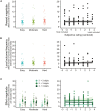P300 as a neural indicator for setting levels of goal scores in educational gamification applications from the perspective of intrinsic motivation: An ERP study
- PMID: 38235471
- PMCID: PMC10790842
- DOI: 10.3389/fnrgo.2022.948080
P300 as a neural indicator for setting levels of goal scores in educational gamification applications from the perspective of intrinsic motivation: An ERP study
Abstract
The challenge level of goal achievement affects intrinsic motivation. Thus, the goal score learners are required to achieve is an important element in gamified educational applications to foster users' intrinsic motivation. However, determining optimal goal scores that enhance the intrinsic motivation of each learner is not easy because individual competence and preferences for the challenge level (e.g., preference for difficult-to-achieve challenges) vary. One approach is to determine the goal score using physiological measurements to estimate when an individual's intrinsic motivation is reinforced. Measurement of event-related potentials (ERPs) is considered useful for this purpose. ERPs time-locked to feedback onset, such as feedback-related negativity and P300, reflect intrinsic motivation. However, it remains unclear whether these ERPs can serve as indicators of optimal goal scores for gamified educational applications in terms of intrinsic motivation. The present study aimed to examine whether ERP measures vary with the challenge levels of the goal score determined by participants' competence (too-easy, moderate and too-hard levels) and/or with their preference for these levels when using a gamified mental arithmetic application. Thirty-three participants solved 64 addition problems in one session in this application and received auditory feedback immediately after each answer entry. Scores were then calculated based on their task performance. Before each session, participants were informed of the goal score and instructed to exceed it as much as possible. Sessions were repeated six times at easy, moderate, and hard levels of goal scores, with two sessions per level. Goal score preferences were quantified based on subjective ratings of the motivation to achieve each level of goal score using a 7-point Likert scale. The mean amplitudes of ERPs were obtained for each participant. Results showed that P300 was significantly related to subjective ratings but not to levels of goal scores, indicating that P300 could be an indicator of participant preference for goal score levels. This study suggests that measurement of P300 may serve as a neural indicator providing an optimal goal score for individual learners that maximizes their intrinsic motivation in gamified learning applications.
Keywords: P300; achievement goal; electroencephalogram (EEG); event-related potentials (ERPs); feedback-related negativity (FRN); gamification; intrinsic motivation; self-determination theory (SDT).
Copyright © 2022 Watanabe and Naruse.
Conflict of interest statement
The authors declare that the research was conducted in the absence of any commercial or financial relationships that could be construed as a potential conflict of interest.
Figures








References
-
- Deci E. L., Ryan R. M. (1985). Intrinsic Motivation and Self-Determination in Human Behavior. New York, NY: Plenum Press.
-
- Deterding S., Dixon D., Khaled R., Nacke L. (2011). “From game design elements to gamefulness: Defining “gamification,” in Proceedings of the 15th International Academic MindTrek Conference: Envisioning Future Media Environments (Tampere: ), 9–15.
LinkOut - more resources
Full Text Sources
Miscellaneous

